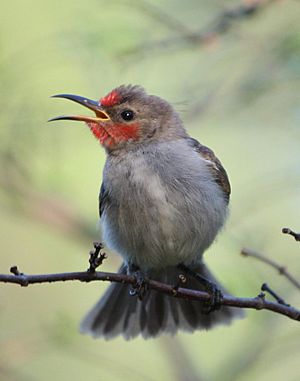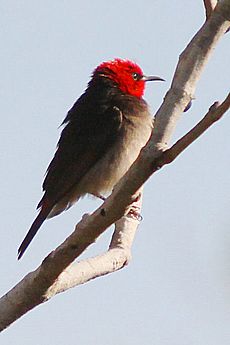Red-headed myzomela facts for kids
Quick facts for kids Red-headed myzomela |
|
|---|---|
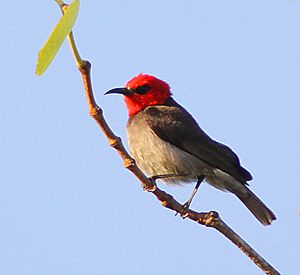 |
|
| Male perched on a mangrove branch. | |
| Conservation status | |
| Scientific classification | |
| Genus: |
Myzomela
|
| Species: |
erythrocephala
|
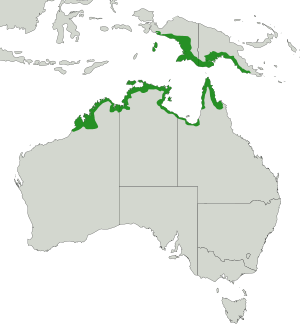 |
|
| Red-headed myzomela natural range | |
The red-headed myzomela or red-headed honeyeater (Myzomela erythrocephala) is a small bird that belongs to the honeyeater family. You can find it in Australia, Indonesia, and Papua New Guinea. This bird was first described by a person named John Gould in 1840.
It's a small honeyeater, about 12 cm (4.7 in) long, with a short tail and a bill that curves downwards. Male and female red-headed myzomelas look different. The male has a bright red head and brown body, while the female is mostly grey-brown. This bird loves to live in tropical mangrove forests. It's very active when it eats, flying quickly from flower to flower to find food. It also makes sounds constantly while it's feeding.
Contents
About the Red-Headed Myzomela
The red-headed myzomela was first named Myzomela erythrocephala by John Gould in 1840. He found specimens of this bird in King Sound, which is in northern Western Australia. The name Myzomela comes from old Greek words meaning 'to suckle' and 'honey'. This refers to how the bird drinks nectar from flowers. The word erythrocephala means 'red head' in Greek, which perfectly describes the male bird.
This bird is also known by other names like red-headed honeyeater, mangrove red-headed honeyeater, and blood-bird.
Different Types of Red-Headed Myzomelas
There are two main types, or subspecies, of the red-headed myzomela. One is called M. e. erythrocephala, which is the original type. The other is M. e. infuscata, which was described in 1879. This second type has more red on its back and lighter brown upper parts.
The red-headed myzomela is part of the Myzomela group of birds. This group also includes other Australian birds like the scarlet myzomela and the dusky myzomela. All these birds belong to the honeyeater family.
What Does the Red-Headed Myzomela Look Like?
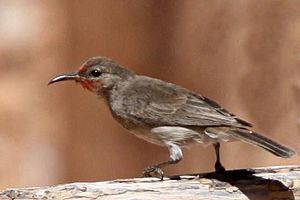
The red-headed myzomela is a small, unique honeyeater. It has a compact body, a short tail, and a bill that curves downwards. On average, it is about 12 cm (4.7 in) long. Its wingspan is between 17 and 19 cm (6.7 and 7.5 in), and it weighs around 8 grams (0.28 oz).
Male and female birds look different, which is called sexual dimorphism. Males are a bit bigger and much brighter in color than females.
Male and Female Birds
The adult male has a shiny dark red head, neck, and rump. The rest of its upper body is blackish-brown, and its belly is a light brownish-grey. The red on its head is very clear, making it look like it's wearing a red hood. Its bill is black, and its eyes are dark brown.
The adult female's head and neck are grey-brown, but they have a little pink-red color on their forehead and chin. The rest of her body is grey-brown, with darker wings and lighter underparts.
Young birds look similar to females at first. They don't have red feathers, but they start to get them on their faces after about a month. Males take up to three months to get their full bright colors.
Bird Calls
The red-headed myzomela makes different sounds. Its calls are often described as metallic or scratchy. Its song is a quick tchwip-tchwip-tchwip-tchwip. It also has a softer swip-swip-swip-swip call and a scolding charrk-charrk sound.
Where Do Red-Headed Myzomelas Live?
The red-headed myzomela lives along the tropical coastlines of Western Australia, the Northern Territory, and Queensland. You can also find them on various islands off the coast. The other subspecies, M. e. infuscata, lives in parts of Papua New Guinea and the Aru Islands.
Even though these birds are found in many places, they are not super common everywhere. The largest group found was about 5.5 birds per hectare (2.2 per acre) in Palmerston, Northern Territory. They are most common in the mangroves around Darwin Harbour when young birds are being born and when yellow mangrove flowers are blooming.
Bird Movements
Scientists don't fully understand how these birds move around. Some say they stay in one place, while others say they move from place to place or even migrate. Their numbers might change in some areas depending on when their favorite mangrove and Melaleuca trees are flowering.
These birds can travel across water. One bird was found 27 km (17 mi) away from where it was first tagged, almost five years later. They also live on many offshore islands, which shows they are good at flying over water. The oldest recorded red-headed myzomela lived for 7 years and 1.5 months.
Their Home: Mangrove Forests
The red-headed myzomela mostly lives in mangrove forests in coastal areas, especially in thick groups of spotted mangrove, smallflower bruguiera, and grey mangrove. These forests are often found along islands or in river deltas. They also live in paperbark thickets that grow next to mangroves.
Mangroves are very important to these birds. They provide nectar and insects for food, as well as safe places to shelter and build nests. In Australia, mangrove forests form a narrow strip along the coast, which is perfect for birds that specialize in this type of home.
Sometimes, you might find the red-headed myzomela in swampy woodlands, casuarina woodlands, and open forests, especially those with Pandanus trees and paperbarks. They can also be seen on coconut farms.
How Red-Headed Myzomelas Behave
Social Life
Not much is known about how red-headed myzomelas interact with each other. They are usually seen alone or in pairs. However, they have been seen in loose groups with other birds that feed in mangroves, like brown honeyeaters and yellow white-eyes.
These birds are curious. If you make a "pish" sound, they might come closer to see what's happening and to warn you away. They call all day long while they are eating. Males also sing from high branches in the trees where they find food.
Red-headed myzomelas are very protective of their food trees. They will chase away other birds, even other red-headed myzomelas. Males will fight by grabbing onto each other in the air and falling towards the ground before letting go. They often chase brown honeyeaters, but they haven't been seen fighting other types of birds in the same way.
Reproduction and Life Cycle
There aren't many scientific reports about how red-headed myzomelas breed. A study in the western Kimberley area found that the birds hold their own areas during most of the dry season and then spread out.
The nest is built in the leaves of mangrove trees. It hangs from a small horizontal branch, usually about 6 to 10 meters (20 to 33 ft) above the ground or water. The nest is small and shaped like a cup. It's made from small pieces of bark, leaves, and plant fibers, sometimes even seaweed. These materials are held together with spider web and lined with softer stuff. The nest is usually about 5.4 cm (2.1 in) wide and 3.7 cm (1.5 in) deep.
The eggs are oval-shaped, smooth, and dull white. They are about 16 by 12 mm (0.63 by 0.47 in) in size and have small red spots or blotches on the wider end. A female bird usually lays two or three eggs. It is believed that both parents help take care of the young birds. One study suggested that only the females sit on the eggs to keep them warm.
What Do They Eat?
The red-headed myzomela spends its time in trees, feeding on flowers and among the leaves of mangroves and other flowering trees. It's very active when it eats, darting from flower to flower to find nectar with its long, curved bill. It also picks insects off leaves and twigs. Sometimes, it will fly out to catch insects in the air.
They eat spiders and insects like beetles, bugs, wasps, and caterpillars. Red-headed myzomelas mostly eat from mangrove species. In northwest Australia, they are very important for helping the rib-fruited mangrove reproduce by carrying pollen from flower to flower.
They also feed in paperbark trees and other coastal forests. They have even been seen eating from cultivated bottlebrush and Grevillea plants in gardens in Darwin.
Conservation Status
The red-headed myzomela is listed as being of "Least Concern" by the IUCN. This means that the bird's population is widespread, and it's not currently in danger of disappearing.
However, the Australian population of the M. e. infuscata subspecies is listed as "Near Threatened". This is because it only lives on three small islands, which together are about 100 square kilometers (39 sq mi) in size.
There isn't an immediate threat to the red-headed myzomela. But, there is a risk to low-lying islands from rising sea levels. Some people have suggested that promoting ecotourism (tourism that helps the environment) in coastal areas could help. This could lead to birdwatchers and local rangers keeping an eye on the bird populations and their homes.
|
See also
 In Spanish: Mielero cabecirrojo para niños
In Spanish: Mielero cabecirrojo para niños



